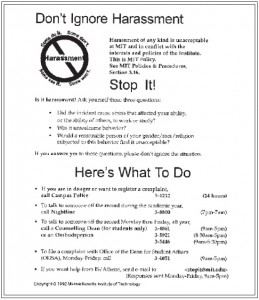Revisiting IT Policy #3: Harassment
 The so-called “star wars” campuses of the mid-1980s (Brown, Carnegie Mellon, Dartmouth, and MIT) invented (or at least believe they invented–IT folklore runs rampant) much of what we take for granted and appreciate today in daily electronic life: single signon, secure authentication, instant messaging, cloud storage, interactive online help, automatic updates, group policy, and on and on.
The so-called “star wars” campuses of the mid-1980s (Brown, Carnegie Mellon, Dartmouth, and MIT) invented (or at least believe they invented–IT folklore runs rampant) much of what we take for granted and appreciate today in daily electronic life: single signon, secure authentication, instant messaging, cloud storage, interactive online help, automatic updates, group policy, and on and on.
They also invented things we appreciate less. One of those is online harassment, which takes many forms.
Early in my time as MIT’s academic-computing head, harassment seemed to be getting worse. Partly this was because the then-new Athena computing environment interconnected students in unprecedentedly extensive ways, and partly because the Institute approached harassment purely as a disciplinary matter–that is, trying to identify and punish offenders.
Those cases rarely satisfied disciplinary requirements, so few complaints resulted in disciplinary proceedings. Fewer still led to disciplinary action, and of course all of that was confidential.
Stopit
 Working with Mary Rowe, who was then the MIT “Ombuds“, we developed a different approach. Rather than focus on evidence and punishment, we focused on two more general goals: making it as simple as possible for victims of harassment to make themselves known, and persuading offenders to change their behavior.
Working with Mary Rowe, who was then the MIT “Ombuds“, we developed a different approach. Rather than focus on evidence and punishment, we focused on two more general goals: making it as simple as possible for victims of harassment to make themselves known, and persuading offenders to change their behavior.
The former required a reporting and handling mechanism that would work discreetly and quickly. The latter required something other than threats.
 Satisfying the first requirement was relatively simple. We created an email alias (stopit@mit.edu) to receive and handle harassment (and, in due course, other) complaints. Email sent to that address went to a small number of senior IT and Ombuds staff, collectively known as the Stopits. The duty Stopit–often me–responded promptly to each complaint, saying that we would do what we could to end the harassment.
Satisfying the first requirement was relatively simple. We created an email alias (stopit@mit.edu) to receive and handle harassment (and, in due course, other) complaints. Email sent to that address went to a small number of senior IT and Ombuds staff, collectively known as the Stopits. The duty Stopit–often me–responded promptly to each complaint, saying that we would do what we could to end the harassment.
We publicized Stopit widely online, in person, and with posters. In the poster and other materials, we gave three criteria for harassment:
- Did the incident cause stress that affected your ability, or the ability of others, to work or study?
- Was it unwelcome behavior?
- Would a reasonable person of your gender/race/religion subjected to this find it unacceptable?”
Anyone who felt in danger, we noted, should immediately communicate with campus police or the dean on call, and we also gave contact information for other hotlines and resources. Otherwise, we asked that complainants share whatever specifics they could with us, and promised discretion under most circumstances.
To satisfy the second requirement, we had to persuade offenders to stop–a very different goal, and this is the key point, from bringing them to justice. MIT is a laissez-faire, almost libertarian place, where much that would be problematic elsewhere is tolerated, and where there is a high bar to formal action.
As I wrote in an MIT Faculty Newsletter article at the time, we knew that directly accusing offenders would trigger demands for proof and long, futile arguments about the subtle difference between criticism and negative comments–which are common and expected at the Institute–and harassment. Prosecution wouldn’t address the problem.
UYA
And so we came up with the so-called “UYA” note.
“Someone using your account…”, the note began, and then went on to describe the alleged behavior. “If you did not do this,” the note went on, “…then quite possibly someone has managed to access your account without permission, and you should take immediate steps to change your password and not share it with anyone.” The note then concluded by saying “If the incident described was indeed your doing, we ask that you avoid such incidents in the future, since they can have serious disciplinary or legal consequences”.
 Almost all recipients of UYA notes wrote back to say that their accounts had indeed been compromised, and that they had changed their passwords to make sure their accounts would not be used this way again. In virtually all such cases, the harassment then ceased.
Almost all recipients of UYA notes wrote back to say that their accounts had indeed been compromised, and that they had changed their passwords to make sure their accounts would not be used this way again. In virtually all such cases, the harassment then ceased.
Did we believe that most harassment involved compromised accounts, and that the alleged offenders were innocent? Of course not. In many cases we could see, in logs, that the offender was logged in and doing academic work at the very workstation and time whence the offending messages originated. But the UYA note gave offenders a way to back off without confession or concession. Most offenders took advantage of that. Our goal was to stop the harassment, and mostly the UYA note achieved that.
 There was occasional pushback, usually the offender arguing that the incident was described accurately but did not constitute harassment. Here again, though, the offending behavior almost always ceased. And in a few cases there was pushback of the “yeah, it’s me, and you can’t make me stop” variety. In those, the Stopits referred the incident into MIT’s disciplinary process. And usually, regardless of whether the offender was punished, the harassment stopped.
There was occasional pushback, usually the offender arguing that the incident was described accurately but did not constitute harassment. Here again, though, the offending behavior almost always ceased. And in a few cases there was pushback of the “yeah, it’s me, and you can’t make me stop” variety. In those, the Stopits referred the incident into MIT’s disciplinary process. And usually, regardless of whether the offender was punished, the harassment stopped.
So Stopit and UYA notes worked.
Looking back, though, they neglected some important issues, and those remain problematic. In fact, the two teaching cases I mentioned in the Faculty Newsletter article and have used in myriad class discussions since–Judy and Michael–reflect two such issues: the difference between harassment and a hostile work environment, and jurisdictional ambiguity.
Work Environment
 Judy Hamilton complains that images displayed on monitors in a public computing facility make it impossible for her to work comfortably. This really isn’t harassment, since the offending behavior isn’t directed at her. Rather, the offender’s behavior made it uncomfortable for Judy to work even though the offender was unaware of Judy or her reaction.
Judy Hamilton complains that images displayed on monitors in a public computing facility make it impossible for her to work comfortably. This really isn’t harassment, since the offending behavior isn’t directed at her. Rather, the offender’s behavior made it uncomfortable for Judy to work even though the offender was unaware of Judy or her reaction.
The UYA note worked: the offender claimed that he’d done nothing wrong, and that he had every right to display whatever images he chose so long as they weren’t illegal, but nevertheless he chose to stop.
But it was not correct to suggest that he was harassing Judy, as we did at the time. Most groups that have discussed this case over the years come to that conclusion, and instead say this should have been handled as a hostile-work-environment case. It’s an important distinction to keep in mind.
Jurisdiction
 Michael Zareny, on the other hand, is interacting directly with Jack Oiler, and there’s really no work environment involved. Jack feels harassed, but it’s not clear Michael’s behavior satisfies the harassment criteria. Jack appears to be annoyed, rather than impaired, by Michael’s comments. In any case the interaction between the two would be deemed unfortunate, rather than unacceptable, by many of Jack’s peers.
Michael Zareny, on the other hand, is interacting directly with Jack Oiler, and there’s really no work environment involved. Jack feels harassed, but it’s not clear Michael’s behavior satisfies the harassment criteria. Jack appears to be annoyed, rather than impaired, by Michael’s comments. In any case the interaction between the two would be deemed unfortunate, rather than unacceptable, by many of Jack’s peers.
Or, and this is a key point, the interaction would be seen that way by Jack’s peers at MIT. There’s an old Cambridge joke: At Harvard people are nice to you and don’t mean it, and MIT people aren’t nice to you and don’t mean it. The cultural norms are different. What is unacceptable to someone at Harvard might not be to someone at MIT. So arises the first jurisdictional ambiguity.
In the event, the Michael situation turned out to be even more complicated. When Kim tried to send a UYA note to Michael, it turned out that there was no Michael Zareny at MIT. Rather, it turned out that Michael Zareny was a student elsewhere, and his sole MIT connection was interacting with Jack Oiler in an the newsgroup.
There thus wasn’t much Kim could do, especially since Michael’s own college declined to take any action because the problematic behavior hadn’t involved its campus or IT.
Looking Ahead
The point to all this is straightforward, and it’s relevant beyond the issue of harassment. In today’s interconnected world, it’s rare for problematic online behavior to occur within the confines of a single institution. As a result, taking effective action generally requires various entities to act consistently and collaboratively to gather data from complainants and dissuade offenders.
Yet the relevant policies are rarely consistent from campus to campus, let alone between campuses and ISPs, corporations, or other outside entities. And although campuses are generally willing to collaborate, this often proves difficult for FERPA, privacy, and other reasons.
It’s clear, especially with all the recent attention to online bullying and intimidation, that harassment and similarly antisocial behavior remain a problem for online communities. It’s hard to see how this will improve unless campuses and other institutions work together. If they don’t do that, then external rules–which most of us would prefer to avoid–may well make it a legal requirement.